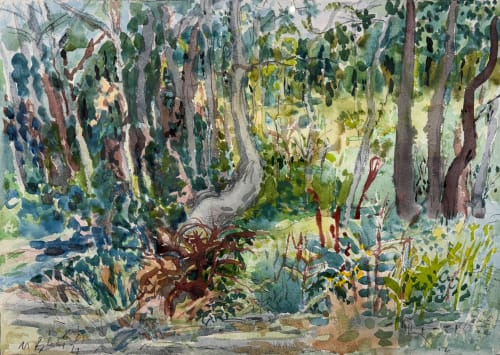Nell Blaine was born in Richmond, Virginia in 1922. She had a difficult childhood, suffering both physically and emotionally. She underwent several surgeries to correct her extremely poor vision at an early age. Her father, who never got over the death of his first wife, was cold to his daughter, and at times even abusive. He died during the Depression after a long illness that drained the family’s financial resources, leaving little money to provide for his daughter’s future. In the face of all this adversity, however, Blaine was a fighter, and received a working scholarship to the Richmond Professional Institute, an extension of William and Mary College. Unfortunately, the scholarship’s funds ran out, and Blaine was unable to finish her studies. To earn a living, she began working for advertising agencies, doing jobs such as illustrations for the Virginia Chamber of Commerce and Reynolds Metals. Blaine would turn to advertising throughout her life when her finances required it.
Blaine moved to New York City in 1942 at the age of 19, where she said she was “like a bird out of a cage.” She visited the Museum of Non-Objective Art (now the Solomon R. Guggenheim Museum), listened to jazz at the Village Vanguard, and soaked up the culture the bustling city had to offer. She ambitiously enrolled in both the Art Students League and Hans Hofmann’s school. She fully embraced abstraction, and became the youngest member of the American Abstract Artists in 1943. Peggy Guggenheim included Blaine in the exhibition The Women at her Art of This Century Gallery 1945, and Howard Putzel showed her work at his 67 Gallery the following year.
Both Larry Rivers and Jane Freilicher studied under Blaine informally. In 1950 she traveled with Rivers to Paris, a trip that incited her shift away from abstraction and towards representation, a considerably risky move – she was just earning critical acclaim for her abstract works from such respected judges as Clement Greenberg. Upon her return to the states, she started a design service, illustrating exhibition catalogues, drawing cartoons, and even designing the original Village Voice and the first covers for Anchor Books.
By 1956, she was once again on the critics’ and the galleries’ good side, receiving positive feedback for her paintings from nature. She was the subject of an article in Art News, Life included her in an article “Women Painters in Ascendance,” she sold a painting to the Whitney Museum of American Art, and showed regularly with Tibor de Nagy and the Poindexter Gallery in New York.
In 1959, Blaine traded a painting for the use of a studio in Mykonos, Greece. After 5 months, she began to experience curious physical symptoms and was diagnosed with polio. Luckily, the editor of Art News and Blaine’s friend, Thomas Hess, was on a nearby yacht and was able to secure a helicopter to fly her to a hospital in Athens. While there, Blaine underwent several procedures that saved her life, including a tracheotomy, but the illness quickly grew worse. By the time she was moved to Germany, where the closest iron lung was, she could only move her head and her left hand. She was finally transported back to New York, where she remained in the iron lung at Mount Sinai hospital for another five months.
During this traumatic and painful time, however, Blaine never gave up. She was in the hospital for a total of seven months, and despite being told that she would never paint again, she devoted herself to her physical therapy and was soon doodling and giving drawing lessons to the nurses. 79 of her artist friends, including Larry Rivers, the de Koonings, Saul Steinberg, Robert Motherwell, Philip Guston, Jane Freilicher, and Robert Rauschenberg, organized the exhibition To Nell Blaine at the Poindexter Gallery, donating their work to pay for her considerable hospital expenses.
Blaine was back to living and painting in her Riverside Drive apartment by 1960. Elinor Poindexter worked tirelessly to promote Blaine’s career, and this continued support allowed her to produce a steady flow of lyrical works, oils that she painted with her stronger, left hand, and watercolors that she painted with her right. She received several grants, including from the Guggenheim and the National Endowment for the Arts. Blaine attended few openings, but remained in touch with her several friends through correspondence. She purchased a summer home in Gloucester, Massachusetts, whose seaside views and quaint town became subjects in her work. Blaine fully acknowledged that painting was her form of escapism; her works are vibrant and cheerful because that is how she felt when she painted them. She continued with her positive outlook on life and her art until 1996, when she died at age 74 in New York City from respiratory failure brought on by post-polio syndrome.

